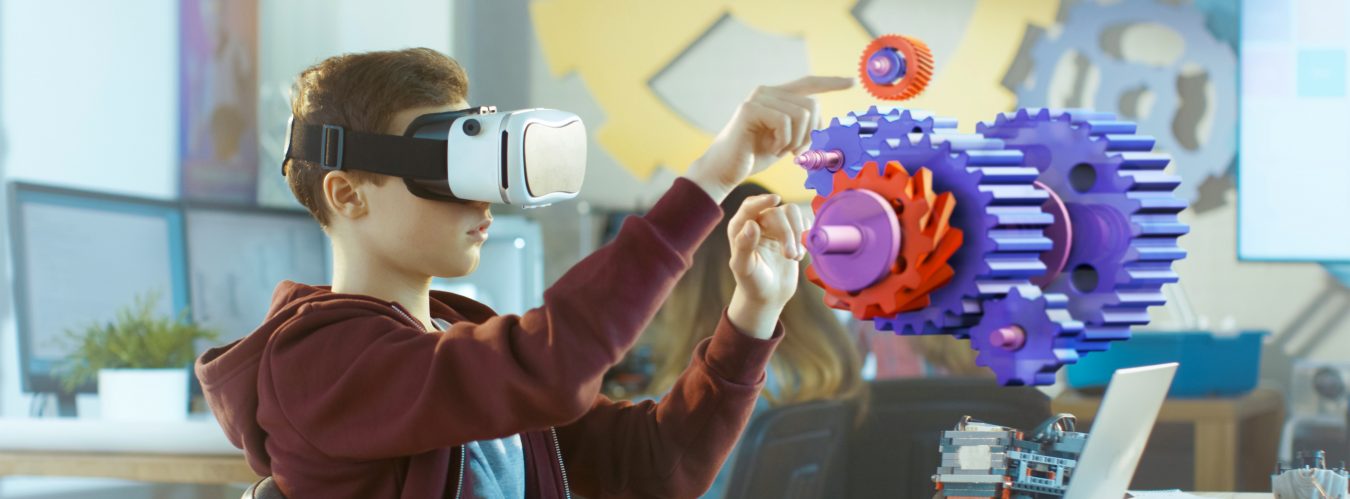Just before Christmas, the Digital Learning Team hosted a visit by Altro Orbis, a company specialising in VR experiences. We asked them to bring a couple of HTC Vive rigs (one of the market leaders in VR hardware) and invited staff from faculties and Professional Services to come along and try out something a little bit…different.
Between the Hololens early adopters group, Virtual Fieldwork working group, and our own research/horizon scanning, this is a growing area of interest across the university (as well as education more broadly as the technology becomes faster, cheaper and more accessible). Granted, the ‘classroom of tomorrow’ (as visualised in this Samsung ad for their VR alternative to Vive) won’t quite be here tomorrow… but how close are we? Class logistics aside, how ‘real’ is the experience for an individual?
Altro Orbis brought us a range of apps and experiences. It would take too long to describe them all in detail, so I’ve chosen a couple of highlights…
First up we tried ‘Richie’s Plank Experience’. Often people worry about looking silly whilst wearing the headsets. As I had arranged the visit I thought I should get the feeling of self-consciousness out of the way and go first. I stood in the middle of a room full of people, put on the visor and took the controller that was put into my hand. The city scene that I was now looking at was decidedly like a computer game; a high end one graphics-wise and detailed, but still not a ‘real’ place. I walked into the lift and pressed a button. When the doors opened, several floors up, there was simply a plank leading out of the lift and over a significant drop either side. The Altro Orbis team had laid out a plank on the ground, so there was a centimetre drop to the true ground (and usually they would have a fan gently blowing when the doors open); just that centimetre was enough to fool my feet and brain. A primaeval sense of touch took over enough to distract my eyes and brain from the level of detail in the environment. It is convincing enough that there is a 50:50 failure rate for participants. I’m glad to say I wasn’t in the 50% that cower in the ‘back’ of the lift and refuse to go any further; I walked the plank, and eventually jumped off, but it was very challenging! You can see the trailer for the experience below:

An experience that I thought was especially interesting was a virtual tour of a small churchyard. The environment was created by taking a large number of still photographs from various angles, and a 3D model was generated using software that Archaeology already use to great effect and Digital Learning have started to get to grips with. The 3D model was then further enhanced by adding locations that the user can move to, and pop-up information about headstones and architecture. In Digital Learning we saw the beginnings of a workflow that would enable us to create virtual environments utilising expertise within the University. An update for Virtual Fieldwork group members will be on its way soon.
Next, we went for something a little more sedate. The Blu, developed by Wevr, comprises three experiences. The first, a coral reef with turtles, was pleasant and relaxing. For the next one, our colleague Mimi was happily standing on the deck of a shipwreck and interacting with a small shoal of fish when a huge whale loomed up out of the gloom. Once she had gotten over the shock (real enough to make her jump backwards with a shout) she could examine it more closely.

The final experience, Luminous Abyss, was breathtakingly atmospheric. In the morning I had started the day by jumping off of a skyscraper; now I was finishing the day at the bottom of the ocean in complete darkness. My controller was now a torch and I was surrounded by whale bones arching away into the darkness. I honestly don’t want to write more about that final one as experiencing it firsthand was so powerful. To give you spoilers would detract from the impact it will have on you – and you really should give it a go! A word of advice – don’t go looking for it on Youtube either. It’s really not the same.
We are hoping to arrange a collaborative stand at Science and Engineering Day this year. A combination of two iSolutions teams, plus staff from OES who can supplement The Blu experiences with UoS research, will be bringing this to a wider audience. If you want to try it for yourself please drop us a line. We can challenge a few myths and misconceptions about this technology!


